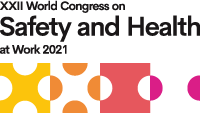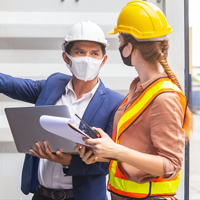Scheduled maintenance - Thursday, July 12 at 5:00 PM EDT
We expect this update to take about an hour. Access to this website will be unavailable during this time.
On Topic

During the COVID-19 pandemic, more people have turned to online shopping. Workers in warehouses and distribution centres are essential to fulfilling these ever-growing number of orders, from picking to packing to shipping. This warehouse work can be fast-paced and involve machinery and automated processes. Employers can take steps to protect against COVID-19 transmission and keep their warehouse workers safe and healthy.
Risks and Hazards
Working in a warehouse puts workers in direct contact with machinery such as forklifts, dollies, carts, conveyor belts and various other automated systems. When COVID-19 is considered, the nature of a warehouse also means that many people may work in close proximity to each other, may be in contact with people outside of the organization, and may use or touch the same items touched by others, such as scanners, boxes, envelopes, etc.
Continue to address safety hazards
Storage and racking systems
Pallet racks, usually made of steel, support heavy loads which could collapse and severely injure or kill a worker. These systems should never be overloaded, nor should people climb on them.
Loading and unloading areas
Workers can be exposed to a range of high-risk hazards at indoor and outdoor shipping and receiving areas of workplaces, including loading docks. Working near trucks and forklifts can also expose workers to carbon monoxide poisoning from internal combustion engine emissions due to poor vehicle maintenance and inadequate ventilation.
Slips, trips, and falls
Slips, trips, and falls are some of the leading causes of injuries resulting in lost time at work. Common hazards include slippery surfaces (e.g., oily or greasy), spills of wet or dry substances, changes in walkway levels and slopes, unsecured mats, poor lighting, debris and items stored in pedestrian walkways, trailing cables in pedestrian walkways, smoke, steam or dust obscuring view.
Manual handling
Workers are at risk of back injury and muscular strains from lifting and moving heavy or bulky items of stock. Soreness and loss of function of wrists and arms can also result from repeated awkward movements or vibration or working in one position for a long time. Back pain from lifting heavy or awkward loads and using awkward postures can result from pushing carts and operating pallet jacks.
Responsibilities
Employers and supervisors
Employers are responsible for protecting workers from any hazards in a warehouse. This includes ensuring that equipment, materials, and protective devices are maintained in good condition. During the pandemic, it also means taking steps such as those above to help prevent the spread of the virus.
Workers need to be provided with the information, instruction, and supervision to protect their health and safety. This information includes safe work policies, measures, and procedures specific to the workplace and the work to be performed.
Employers need to ensure that all equipment is maintained and in good condition to prevent mechanical or operational failures. The employer must also review preventive maintenance and inspection reports and follow manufacturers’ instructions for recommended maintenance schedules and practices. Prepare and review, at least annually, a written occupational health and safety policy, and develop and maintain a program to implement that policy. Employers should also develop a procedure and communicate the measures that will be taken to reduce the spread of the coronavirus.
Supervisors are responsible for ensuring that workers comply with these procedures as well as applicable regional occupational health and safety legislation and its regulations. Make sure any equipment, protective device or clothing required is used or worn by workers. Advise workers of any potential or actual health or safety dangers.
Workers
Workers have the responsibility to use or operate equipment in a safe manner and report any issues with the equipment to their supervisor. Any workplace hazards or violations of the occupational health and safety act should also be reported to their supervisor or employer.
Workers should also be aware of their rights under occupational health and safety legislation, including the right to refuse unsafe work and the right to know about any potential hazards to which they may be exposed in the workplace.
COVID-19 pandemic precautions
What employers should do
Developing a COVID-19 business plan will help to make sure that all aspects are managed in a systematic way. The goal of the plan is to make sure that all hazards are identified, the associated risks are assessed, and that control measures are put in place to reduce the spread of the coronavirus. Employers and supervisors must do everything under the circumstances to put the necessary control measures in place, inform workers, and make sure that workers comply with the procedures.
Some steps that employers can take:
What workers can do
To protect themselves and others from COVID-19, workers should self-monitor for symptoms. If you have symptoms or you’re feeling sick, stay at home and away from others, and contact local public health authority for advice. Practice physical distancing by working more than 2 metres (6 feet) apart from co-workers whenever possible. Follow advice from your employer about using a non-medical mask. In general, wear a non-medical mask where physical distancing cannot be maintained, but do not allow the mask to be a hazard to other activities, such as getting caught on moving machinery or equipment. Practice good hygiene by washing your hands often with soap and water, coughing and sneezing into the bend of your arm or a tissue, and not touching your face with unwashed hands. Clean and disinfect frequently touched or shared surfaces and objects often.
Resources:
Partner News

 Following public health guidance on the evolving COVID-19 situation, the XXII World Congress on Safety and Health at Work has been rescheduled to September 19-22, 2021, in Toronto, Canada.
Following public health guidance on the evolving COVID-19 situation, the XXII World Congress on Safety and Health at Work has been rescheduled to September 19-22, 2021, in Toronto, Canada.
Free Special Session October 5-6, 2020
The International Organizing Committee will host a special virtual session focused on COVID-19 and occupational health and safety on October 5-6, 2020.
This free event features thought leaders discussing emerging innovations in addressing COVID-19 in the workplace, how the future of work is being shaped by the global pandemic, and the relevance of promoting a culture of prevention to address COVID-19. The International Labour Organization (ILO) and the International Social Security Association (ISSA) are also organizing a session that will be of interest to the global occupational health and safety community and policy makers. All sessions will be held online, free of charge.
Registration opens in early September 2020 on the Congress website.
The 2021 World Congress is organized by the ILO and the ISSA and is co-hosted by CCOHS and the Institute for Work and Health (IWH).
Podcasts

This month’s feature podcasts include the episode Workplace Inspections During the COVID-19 Pandemic and Maintaining Our Health When Working Remotely.
Podcast: Workplace Inspections During the COVID-19 Pandemic
The COVID-19 global pandemic has created new challenges for workplaces and workplace inspections are changing to adapt to the new reality and the risk posed to workers. Amy Campbell, Health and Safety Program Manager at CCOHS, discusses how workplace inspections have changed during the current COVID-19 pandemic.
The podcast runs 4:03 minutes. Listen to the podcast now.
Podcast: Maintaining Our Health When Working Remotely
The COVID-19 pandemic has challenged employers to equip their workers with the tools they need in order to do their jobs safely at home, and it’s important that this focus includes both mental and physical health. Learn more about what employers and workers can do.
The podcast runs 4:14 minutes. Listen to the podcast now.
CCOHS produces free monthly podcasts on a wide variety of topics designed to keep you current with information, tips, and insights into the health, safety, and well-being of working Canadians. You can download the audio segment to your computer or MP3 player and listen to it at your own convenience... or on the go!
See the complete list of podcast topics. Better yet, subscribe to the series on iTunes and don't miss a single episode. Listen on Spotify.
CCOHS News

Returning to work and resuming activities outside of the home will not be the same as it was before the COVID-19 pandemic began. To facilitate a safe return, CCOHS has released a free Pandemic Planning: Reopening for Business online course.
This course outlines common steps that can be taken to safely reopen during COVID-19. It will help you prepare and put controls in place to help protect workers and customers and minimize the impact of the pandemic.
Topics covered in the course include how coronavirus spreads and its symptoms, employer and worker duties and responsibilities, methods of control (including cleaning and disinfecting), managing the workplace and preparing workers for a safe return, and understanding the impacts of a pandemic on mental health.
Other pandemic-related courses, free until September 30, 2020 include:
More CCOHS Resources:
Infographic

Selecting an appropriate method to control a hazard in the workplace is not always easy. When it comes to the transmission of viruses such as COVID-19, workplaces should consider establishing control measures that have the greatest impact. The main ways to control a hazard, from the most to the least effective, include elimination (and substitution), engineering controls, administrative controls, and personal protective equipment (PPE). In all cases, always practice physical distancing, hand hygiene, and respiratory etiquette.
Share this infographic on how the hierarchy of controls can be applied to COVID-19 in the workplace, including examples of controls for each level.
The Health and Safety Report, a free monthly newsletter produced by the Canadian Centre for Occupational Health and Safety (CCOHS), provides information, advice, and resources that help support a safe and healthy work environment and the total well being of workers.
You can unsubscribe at any time. If you have been sent this newsletter by a friend, why not subscribe yourself?
Concerned about privacy? We don’t sell or share your personal information. See our Privacy Policy.
CCOHS 135 Hunter St. E., Hamilton, ON L8N 1M5
1-800-668-4284 clientservices@ccohs.ca
www.ccohs.ca
© 2025, Canadian Centre for Occupational Health and Safety
Podcast
December 10
October 28-29, 2026